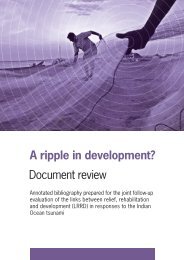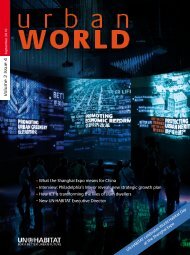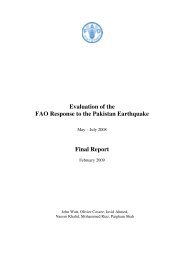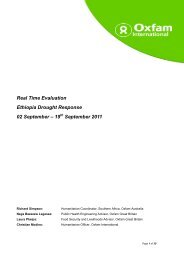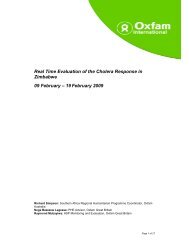Inter-Agency Real Time Evaluation of the Humanitarian ... - alnap
Inter-Agency Real Time Evaluation of the Humanitarian ... - alnap
Inter-Agency Real Time Evaluation of the Humanitarian ... - alnap
You also want an ePaper? Increase the reach of your titles
YUMPU automatically turns print PDFs into web optimized ePapers that Google loves.
IA RTE <strong>of</strong> <strong>the</strong> humanitarian response to Pakistan’s 2010 Floods crisis<br />
75. Considering <strong>the</strong> scale <strong>of</strong> <strong>the</strong> disaster, <strong>the</strong> overall geographical coverage was expectedly<br />
limited, but too focused on accessible areas. <strong>Humanitarian</strong> assistance was mostly concentrated<br />
in larger towns and areas that were more accessible such as <strong>the</strong> Peshawar Valley, Charsadda<br />
and Mansehra in KPK, or Rajanpur and Muzaffargarh districts in Punjab. Smaller communities or<br />
entire areas in <strong>the</strong> same provinces received significantly less or no attention at all. Most people<br />
interviewed mentioned that assistance was proportionally larger in KPK and Punjab than in<br />
Sindh. Coordination within and in‐between clusters was not instrumental in enhancing a clearer<br />
division <strong>of</strong> labour among organisations to ensure a more comprehensive coverage, clearer<br />
prioritisation or rationalised relief efforts. Initially, duplications were reported in some areas,<br />
but were generally dealt with at district coordination levels.<br />
76. The situation on <strong>the</strong> ground changed continuously making it a challenge for <strong>the</strong><br />
humanitarian community to adapt to changing needs in terms <strong>of</strong> contiguum <strong>of</strong> relief and early<br />
recovery as well fast changing locations, primarily due to movements <strong>of</strong> flood affected. In<br />
comparison to Balochistan, Punjab and Sindh, humanitarian actors in KPK, who were already<br />
organised around <strong>the</strong> PDMA/PAARSA structures and working with experienced implementing<br />
partners,were in a better situation to anticipate and adapt to changing needs. The GoP also<br />
differed somehow from UN with regards to <strong>the</strong> emergency’s different stages considering <strong>the</strong><br />
different phases to be much clearly divided. This meant that in some cases <strong>the</strong> transition from<br />
relief to recovery was not understood in <strong>the</strong> same way.<br />
77. At <strong>the</strong> provincial level, <strong>the</strong> response capacity varied substantially and successes depended<br />
largely on <strong>the</strong> proportions <strong>of</strong> damage, <strong>the</strong> government structures in place and <strong>the</strong> presence <strong>of</strong><br />
international and national organisations.<br />
78. Ano<strong>the</strong>r dimension that needs to be considered is that <strong>the</strong> procurement and logistics<br />
pipelines were significantly disrupted. Stocks <strong>of</strong> nationally‐produced relief items (Pakistan<br />
produces some 85% <strong>of</strong> <strong>the</strong> world’s emergency tents shelter) had been shipped to Haiti and not<br />
replenished. When <strong>the</strong> floods hit, <strong>the</strong> production capacity and distribution channels were<br />
heavily disrupted. Only those humanitarian organisations that had national and regional<br />
contingency stocks, such as <strong>the</strong> ICRC, UNICEF, UNHCR, WFP and WHO, could immediately<br />
respond 31 .<br />
Staff capacities and turn‐over<br />
79. The existing human resource capacity and competency was overstretched. The response<br />
was also heavily constrained by insufficient surge capacity as resources had been depleted to<br />
o<strong>the</strong>r disasters, particularly <strong>the</strong> Haiti earthquake. Those human resources that were mobilised,<br />
particularly during <strong>the</strong> initial stages, <strong>of</strong>ten lacked leadership skills to effectively carry out<br />
31<br />
This despite <strong>the</strong> fact that WFP had significant contingency stocks damaged during <strong>the</strong> floods.<br />
Riccardo Polastro, Aatika Nagrah, Nicolai Steen and Farwa Zafar<br />
38







